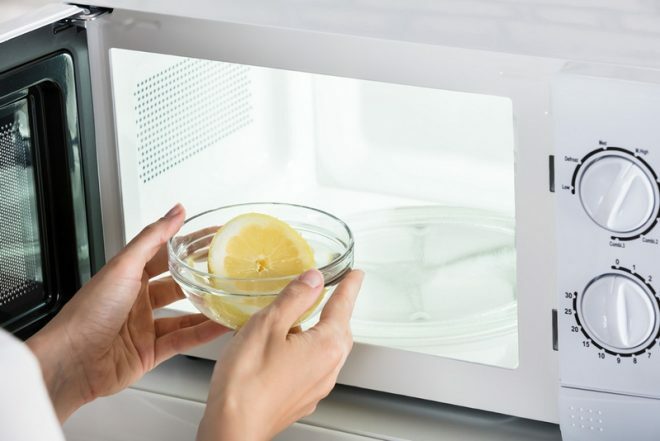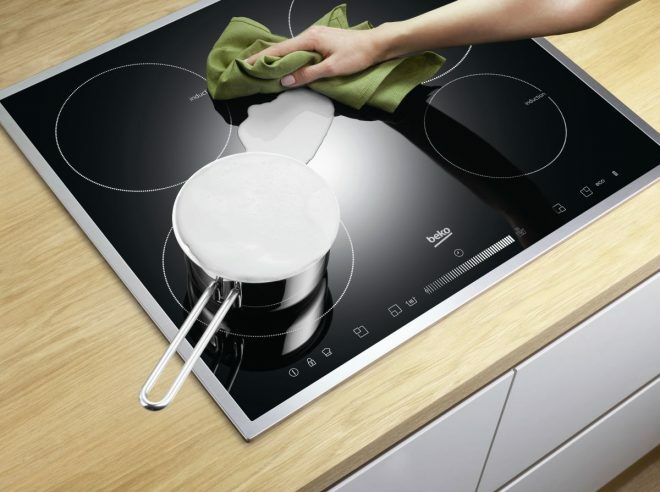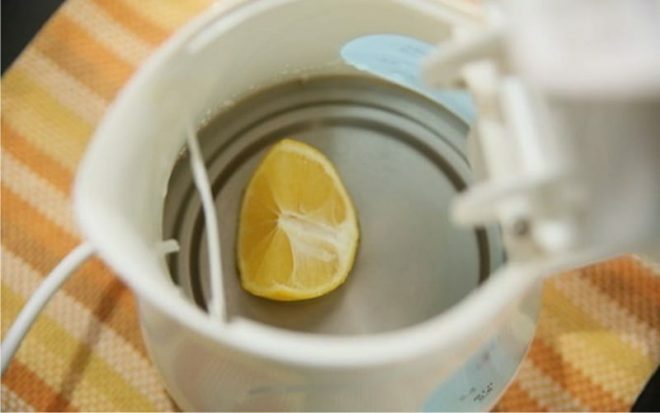After long-term use of dishes for frying food, a thick layer of fat appears on it, which cannot be washed off even with detergents. How to clean the pan of old carbon deposits in order to return the dishes to their original appearance and not harm your health when cooking? After all, burning contains substances that contribute to the formation of malignant cells in the body.
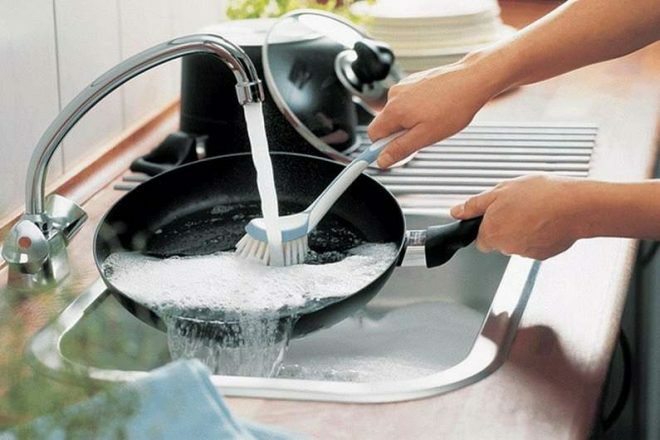
Cleaning preparation
Before you wash your old frying pan, you should determine what material the container is made of. This will help you choose the right cleaning method, the right product, the right scraper. In most cases, old fat can be dealt with with the help of the available tools in every home. The most important thing is to choose the method that works for your pan. After all, the agent that cleans the cast-iron container can ruin the Teflon or ceramic.
Attention! Earned on our website kitchen designer. You can familiarize yourself with it and design your dream kitchen for free! May also come in handy wardrobes designer.
- Cast iron and aluminum containers are not afraid of harsh cleaning, they tolerate the use of abrasive powders and coarse scrapers well.
- Containers with a non-stick Teflon layer do not withstand rough machining with metal scrapers and abrasives. Only gentle methods are used to wash them.
- Spraying ceramic dishes requires careful maintenance for roasting. For cleaning such pans, special melamine rubber sponges are used, which remove dirt of any origin. And as a detergent, neutral gels for dishes are used.
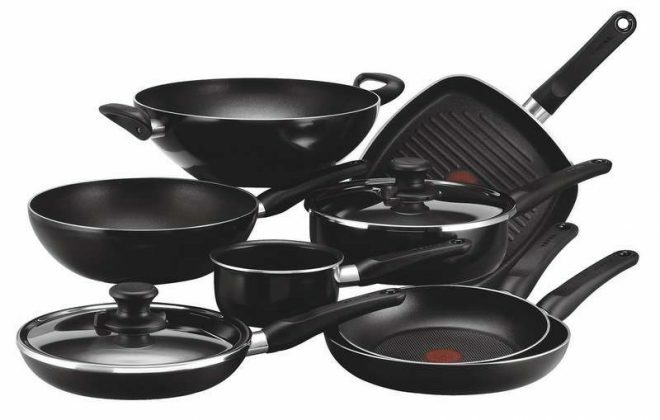
How to clean an old pan
Containers with a large layer of burning and fat immediately catch the eye, compromising the hostess. Therefore, you should know how and how to clean old pans from contamination. Depending on the material from which the containers are made, choose the agent and the method of its application. And before starting the process, soak the pan for 40 minutes in warm water. Add baby detergent and whiteness to the water at the rate of 5 liters of water: 2 tablespoons of detergent and 2 caps of bleach.
Rock salt
Frying pans and pans made of an iron-carbon alloy after using a scraper or knife can deteriorate, become rusty, and food will burn on them. Moreover, black is the normal color for such containers. Therefore, here you need to decide: cook without sticking or have a shiny, cleaned cast iron dish. You can keep unsightly utensils in such places that no one will see it, or you can apply the folk method using rock salt. Before cleaning a cast iron skillet from perennial deposits:
- soak the container for half an hour in hot water with the addition of baby washing powder, dry;
- Pour 200 g of salt into a pan, put on low heat, keeping it for 25-35 minutes;
- turning off the heat, cover the dishes with a lid, leave to cool for one hour;
- use a soft brush and a knife to remove carbon deposits and grease.

Baking soda or soda ash
In most cases, baking soda or lye will help clean the dishes both inside and out. Cleaning with these elements is suitable for aluminum, steel, cast iron, ceramic and Teflon utensils. If you want to clean the container only from the outside, you can use simple boiling of water with alkali. To do this, add 150 g of the substance to 1 liter of water, boil over low heat for half an hour, rinse.
To get rid of a layer of dirt and grease from all sides, you should use a twenty-liter bucket filled with water with the addition of soda or lye, diluted at the rate of: 1500 g of substance for 15 liters. Put a bucket with a container on fire, bring to a boil, set aside for 2 hours. Then remove and clean the dishes.
A special baking soda mixture that you can make at home will remove old grease from a container made of any material. This product works well even for coated dishes that need to be treated with great care. Before you wash a frying pan made of any material from old fat, you should prepare: 700 g of soda ash, 1 bar of laundry soap, 2 vials of silicate stationery glue. Start preparing the product:
- prepare a wide container with a volume of 15L-20L;
- grind laundry soap on a grater, pour into a container;
- add glue and lye, pour 12 liters of water;
- bring the solution to a boil, remove from heat;
- immerse the pan in liquid, leave for 5-6 hours;
- after pulling out the dishes, use a scraper and a knife for cast iron and aluminum containers, and a sponge for dishes for Teflon and ceramic containers.
Vinegar and citric acid
You can remove old fat without resorting to buying store-bought chemicals. Citric acid and vinegar, available to every housewife, will help achieve an excellent result in neutralizing carbon deposits. To do this, you should:
- add to a 5 liter container: 4 liters of water, 2 cups of vinegar, 2 tablespoons of citric acid;
- put the solution on fire, bring to a boil, immerse a frying pan in it, boil for 10 minutes, set aside for 1 hour;
- after pulling out the dishes, clean the carbon deposits with a hard scraper;
- adding 3 tablespoons of washing powder and 50 ml of whiteness to a still hot solution with vinegar and lemon, immerse the pan again for 2 hours;
- after the expiration date, clean the dishes with a soft brush, rinse and dry.
If the dishes are slightly burnt during frying, you can pour into it: 1 tablespoon of lemon, 1 tablespoon of baking soda and 3 tablespoons of vinegar. Boil the mixture for 3-5 minutes, rinse and dry the pan.
Coca Cola
If the coating is slightly greasy, which is not recommended to be scrubbed with a metal scraper, the dirt can be removed with Coca-Cola or Pepsi-Cola. Before you wash the frying pan from not old fat, you should pour the drink into a bucket and boil. Place the contaminated container in a hot solution for 20 hours. During this time, the phosphoric acid contained in the drink will eat away all the carbon deposits.
Hydrogen peroxide
A gruel of hydrogen peroxide and citric acid is a good safe way to remove stubborn dirt from cast iron and steel containers. Before you clean an old cast iron skillet with peroxide, you should soak the dishes in hot water with the addition of baby detergent for 20 hours. After that, start cleaning:
- combine: 1 bottle of hydrogen peroxide, half a glass of baking soda, 1 cap of dish detergent;
- mix the ingredients into a mushy mass, apply to the surface, leave for 30 minutes;
- after this time, wipe the vessel with a soft brush, rinse, dry;
- in case of severe contamination, carry out the procedure two to three times.
Activated carbon
Aluminum is a beautiful and durable material, but it requires special attention to its care. Such frypots cannot be washed in a dishwasher, use abrasive products for cleaning. Ordinary activated carbon will help to cope with the contamination of such dishes. A tool with great surface activity is available in the first-aid kit of every housewife and is able to provide not only a healing effect, but also to restore the cleanliness of the dishes.
Before you clean the old carbon deposits from the aluminum pan, soak it in hot water with the addition of washing powder for one hour. Thereafter:
- pull out the soaked container, dry it a little;
- crush 8 tablets of adsorbent into powder, pour onto the surface of the pan;
- add half a glass of water, put on fire, bring to a boil, set aside for 40 minutes;
- Drain the cooled liquid, wipe the surface with a sponge.
Ammonia and borax
The use of boric acid and ammonia is a harsh chemical method of action, therefore, it is applicable only for cast iron surfaces. To use it:
- in 200 g of water, dilute 5-6 drops of ammonia and one third of a teaspoon of boric acid;
- pour the mixture onto a cast-iron surface, leave for 30-40 minutes;
- after the time has elapsed, drain the resulting dirty liquid, rinse the pan well and dry;
- if necessary, carry out the procedure again.

Sand
The most reliable and ancient method of cleaning cast iron and duralumin braziers is the use of sand. Grains of sand can easily cope with even the oldest carbon deposits. For this:
- soak a frying pan for one hour in warm water with the addition of baking soda;
- pour two glasses of sand on the bottom of the dish, put on fire;
- after the mineral starts to burn, pour out the sand, and clean the pan with a hard scraper.
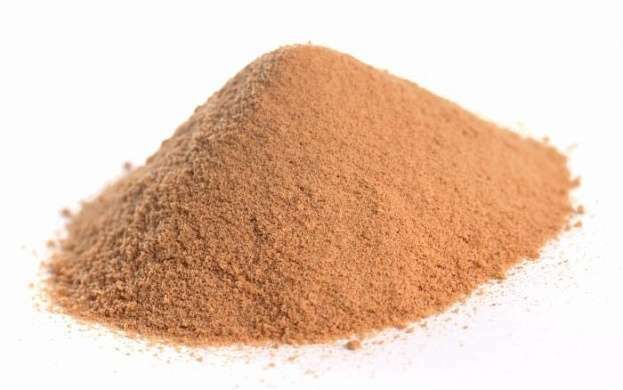
Household chemicals
Since it can be very difficult to clean an old frying pan from soot and fat with improvised means, help housewives receive chemicals that effectively break down fat and get rid of the most persistent pollution. The most popular are:
- Helper Professional. An effective cleaner that penetrates stubborn dirt that is firmly embedded in the surface. Neutralizes and washes them away without damaging the surface.
- Beckmann Grill-Reiniger Aktiv-Gel. A gel that removes even the most stubborn grease from all surfaces. Does not contain abrasives, has a pleasant aroma.
- Xanto Oven Cleaner. Foam paste that removes dirt, grease and carbon deposits. After using the product, no scuffs and scratches remain.
- Astonish Oven Clean Power Spray. A spray that cleans the surfaces of all types of pans. Easily removes carbon deposits, takes good care of ceramic and Teflon containers.
- Gallus Backofen & Grill. Soot remover for all types of dirt and old grease.
- DazhBO. Liquid designed for cleaning all surfaces from carbon deposits and grease. It works actively in both cold and hot environments. Has good adhesive properties.
- Passion Gold. A product that perfectly removes all dirt from grease, soot and carbon deposits. Gives pans their original cleanliness without damaging the surface.
- Well Done. Spray degreaser. Copes well with light carbon deposits on Teflon braziers.
- Blitz backofen & grill. Spray designed to remove carbon deposits from stainless steel surfaces. Kills harmful bacteria and unpleasant odors, gently affects ceramic and Teflon surfaces.
Conclusion
It can be very difficult to bring your favorite frying pan to its original form. Especially if the kitchen item is quite old or badly burnt. However, most contamination can still be dealt with with the tools available in every home. The most important thing is to choose the method that works for the existing pan. After all, a product that cleans a duralumin or cast iron brazier can become unsuitable for a Teflon-coated container.
average rating 0 / 5. Number of ratings: 0
No ratings yet. Be the first to rate.
